Atelier dna
Designed for Site #3 in Abu Dhabi, adjacent to Masdar City Site.
Concept and Design: Darío Núñez Ameni and Thomas Siegl, with Atelier dna
Narrative and Poetics: Gabrielle Jesiolowski
Structure and Engineering: Radhi Majmudar PE, with ISSE Innovative Structural and Specialty Engineering
Ecology and Renewable Energy Strategy: Ian Lipsky, with eDesign Dynamics
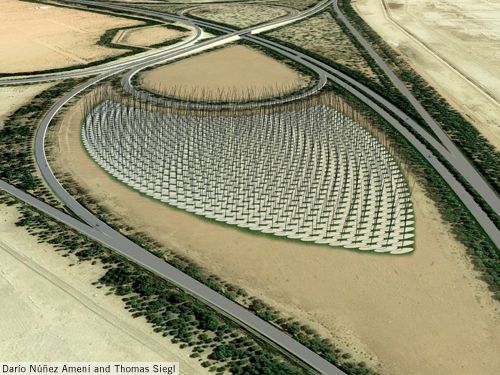
Design Submission for the 2010 Land Art Generator Initiative Design Competition
Second Place Mention from the Jury
Artist’s descriptive text:
MASDAR/WINDSTALK
Our project starts out as a desire, a whisper, like grasping at straws, clenching water.
Our project takes clues from the way the wind caresses a field of wheat, or reeds in a marsh; our hair on a gusty afternoon.
Our project consists of 1203 stalks, 55 meters high, anchored on the ground with concrete bases that range between 10 to 20 meters in diameter. The stalks are made of carbon fiber reinforced resin poles, 30 cm in diameter at the base and 5 cm at the top. The top 50 cm of the poles are lit up by an LED array that glows and dims depending on how much the poles are swaying in the wind. When there is no wind–when the poles are still–the lights go dark.
The bases that support the poles are arrayed along the site following a logarithmic spiral, the kind we see in the center of a sunflower. The bases all
touch each other, forming a kind of carpet, a kind of fabric.

The bases are shaped like vortices–no two vortices are identical–When it rains, the rain water slides down the slopes of the bases to collect in the spaces between, concentrating scarce water. Here, plants can grow wild.
You can walk on the bases of the poles, you can traverse the whole site by walking from base to base. You can lean on the slopes, lie down, stay awhile and listen to the sound the wind makes as it rushes between the poles.
But our project isn’t just desire.
Within each hollow pole is a stack of piezoelectric ceramic discs. Between the ceramic disks are electrodes. Every other electrode is connected to each other by a cable that reaches from top to bottom of each pole. One cable connects the even electrodes, and another cable connects the odd ones. When the wind sways the poles, the stack of piezoelectric disks is forced into compression, thus generating a current through the electrodes.
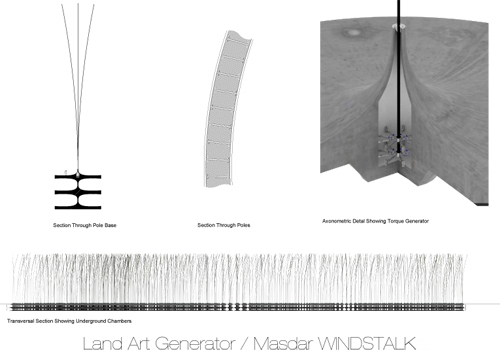
Within each concrete base is a hollow chamber that houses a torque generator.
The generator converts the kinetic energy of the swaying poles into electrical energy by way of an array of current generating shock absorbers, which convert energy produced by the forced movement of fluid through the shock absorber cylinders.
The electricity that our project generates isn’t constant, it depends on the wind.
To compensate we make a kind of battery, a capacitor, a way to store energy:
Below the field of poles are two very large chambers, chambers as large as the whole site. The chambers are shaped like the bases of the poles but inverted, then inverted again, and again and once more.
There’s upper chamber and a lower one beneath. When the wind blows, part of the electricity generated powers a set of pumps, the pumps move water from the lower chamber to the upper one. When the air is still–when there is no wind– the water from the upper chamber flows down again turning the pumps into generators.
Our project is conceptual, yet It is based on a set systems that already exist and work. Our project attempts to combine these systems into a coherent synergetic
whole.
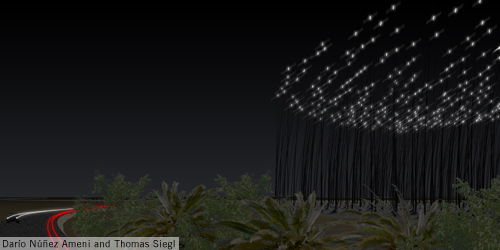
Notes:
The shape of our Windstalks should be optimized to behave as chaotically as possible, they should flutter, oscillate, vibrate. Computer generated simulations can aid in determining and optimizing the best profile for maximizing movement and variation.
We roughly estimate that the overall output of our project is comparable to that of a conventional wind turbine array. While a single wind turbine that is limited in height to 55 meters may produce more energy than one of our Windstalks, our Windstalks can be packed in denser arrays.
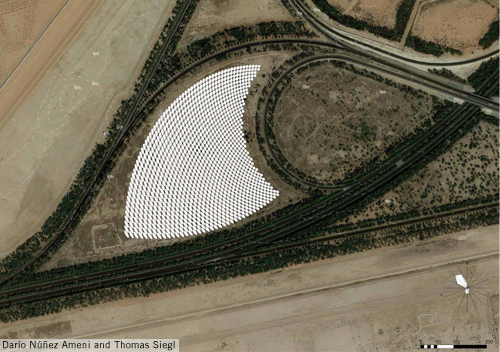
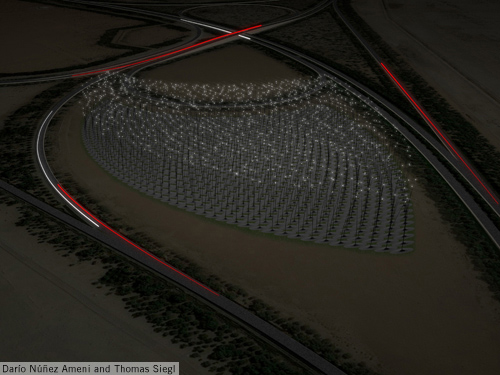

Related Posts
21 Comments
Add comment Cancel reply
This site uses Akismet to reduce spam. Learn how your comment data is processed.

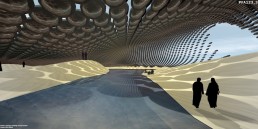
[…] LAGI 2010 (second place mention) design by Atelier dna, Windstalk, takes this idea of energy generation back into the realm of public art in a way that Len Lye may […]
[…] atelierDNA will join LAGI, to demonstrate the science and experience of Windstalk. […]
[…] By Art Renewable Energy Can Be Beautiful by Lindsey Doermann Featuring Windstalk by Darío Núñez-Ameni and Thomas Siegl (Atelier dna), Light Sanctuary by Martina Decker and Peter […]
Beautiful concept. Just curious: How much energy do they create per sqm land use compared to an average wind turbine?
The design team says that the stalks have the ability to create more KWh per square meter area due to the fact that they can be placed closer together than horizontal axis turbines (which see great reductions in efficiency if vortexes from adjacent turbines interfere with the purity of the stream). Also, the cut-in speed is not an issue as the stalks would move in slight breezes. Some Vertical Axis turbines have been shown to be able to be closely spaced and even create more energy as a consequence of vortexes from adjacent turbines. Not sure how the stalks would compare with that.
[…] place mention: Windstalk, Darío Núñez Ameni and Thomas Siegl, with Atelier dna (concept and design), Gabrielle […]
[…] concept « Windstalk » est composé de 1,203 tiges en fibre de carbone renforcée de 55 mètres de haut, ancrées au sol […]
[…] http://landartgenerator.org/blagi/archives/902 […]
[…] Windstalks – a new (and as yet unproven) Wind Power There's one here Land Art Generator Initiative __________________ Never trust a smiling […]
[…] la competición Land Art Generator ha surgido una idea de lo más innovadora en el mundo de la energía eólica. Se llama Windstalk, […]
[…] la competición Land Art Generator ha surgido una idea de lo más innovadora en el mundo de la energía eólica. Se llama Windstalk, […]
[…] la competición Land Art Generator ha surgido una idea de lo más innovadora en el mundo de la energía eólica. Se llama Windstalk, […]
[…] : Land Art Generator Initiative via Buzz […]
[…] Landartgenerator / Masdar / […]
[…] concept « Windstalk« est composé de 1,203 tiges en fibre de carbone renforcée de 55 mètres de haut, […]
Ingenius and very artistic.
[…] convoca anualmente para proyectos relacionados con las fuentes de energías renovables. El proyecto Windstalk, un parque eólico inspirado en la naturaleza y el medio rural diseñado por Atelier DNA, ha […]
[…] or dim depending on how much wind is present. When wind is completely absent, the LEDs stay dark. The Windstalk remains a concept, although its creators say that “It is based on a set of systems that already […]
[…] View Source: Land Art Generator […]
[…] + Land Art Generator […]
Beautiful .. Congratulations !